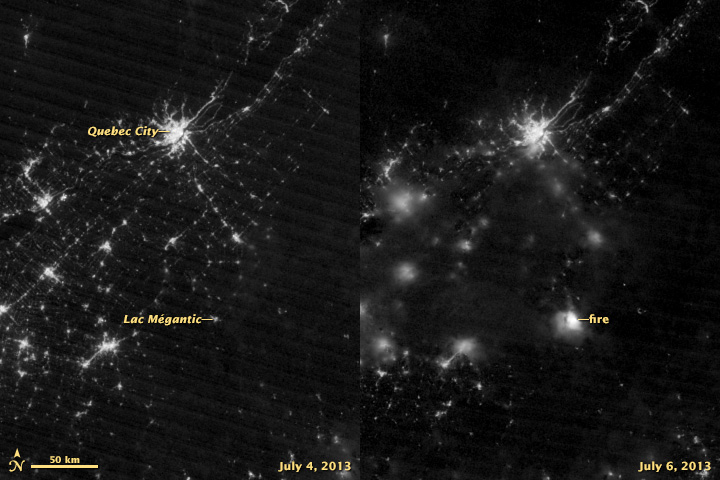
acquired July 4 - 6, 2013
acquired July 4, 2013
download large image (626 KB, JPEG, 2000x2000)
acquired July 4, 2013
download GeoTIFF file (2 MB, TIFF)
acquired July 6, 2013
download large image (634 KB, JPEG, 2000x2000)
acquired July 6, 2013
download GeoTIFF file (2 MB, TIFF)
acquired July 4 - 6, 2013
download Google Earth file (KML)
Early in the morning on July 6, 2013, a train carrying crude oil derailed in Lac-Mégantic, Quebec.
The resulting crash and series of explosions killed at least 13
people, destroyed 40 homes, and forced 2,000 people to evacuate the
town. The fire was visible to the Visible Infrared Imaging Radiometer Suite (VIIRS) on the Suomi NPP satellite.
The image on the right was acquired at 6:21 GMT (2:21 a.m. local
time) on July 6 by the instrument’s “day-night band,” which detects
light in a range of wavelengths from green to near-infrared and uses
filtering techniques to observe signals such as city lights,
auroras, fires, and reflected moonlight. The image on the left, shown
for comparison, was acquired by the same instrument on July 4, before
the derailment. Light sources are not as crisp in the July 6 image
because of cloud cover.
VIIRS is a spectroradiometer,
detecting photons of light in 22 different wavelength bands and
collecting them in a similar fashion to the charge-coupled device in
your digital camera. Unlike a film camera that captures a photograph in
one exposure, VIIRS produces an image by repeatedly scanning a scene and
resolving it as millions of individual picture elements, or pixels.
The day-night band goes a step further, determining on-the-fly
whether to use its low, medium, or high-gain mode to ensure that each
pixel accurately depicts the amount of light emitted. VIIRS can
distinguish night lights with six times better spatial resolution and
250 times better resolution of lighting levels (dynamic range) than its
predecessor instrument—the Operational Linescan System, which was flown
as part of the Defense Meteorological Satellite Program (DMSP).
References
- CBC (2013, July 8) 8 more bodies found in Lac-Mégantic, raising death toll to 13. Accessed July 8, 2013.
- CIMSS Satellite Blog (2013, July 6) Train derailment fire in Lac-Mégantic, Quebec. Accessed July 8, 2013.
- CNN (2013, July 8) About 40 still missing after runaway train crashes, explodes in Canadian town. Accessed July 8, 2013.
- New York Times (2013, July 8) The Long Chain of Responsibility Behind an Oily and Deadly Train Wreck. Accessed July 8, 2013.
Further Reading
- NASA Earth Observatory (2012, December 5) Earth at Night 2012: It’s the end of the night as you know it; you’ll see fine.
NASA Earth Observatory image by Jesse Allen and Robert Simmon, using VIIRS Day-Night Band data from the Suomi National Polar-orbiting Partnership.
Suomi NPP is the result of a partnership between NASA, the National
Oceanic and Atmospheric Administration, and the Department of Defense.
Caption by Adam Voiland.
- Instrument:
- Suomi NPP - VIIR
NASA: Canada - Train Derailment and Fire, Lac Mégantic, Quebec - 12.07.13
Ricardo M Marcenaro - Facebook
Blogs in operation of The Solitary Dog:
Solitary Dog Sculptor:
http://byricardomarcenaro.blogspot.com
Solitary Dog Sculptor I:
http://byricardomarcenaroi.blogspot.com
Para:
comunicarse conmigo,
enviar materiales para publicar,
propuestas comerciales:
marcenaroescultor@gmail.com
For:
contact me,
submit materials for publication,
commercial proposals:
marcenaroescultor@gmail.com
My blogs are an open house to all cultures, religions and countries. Be a follower if you like it, with this action you are building a new culture of tolerance, open mind and heart for peace, love and human respect.
Thanks :)
Mis blogs son una casa abierta a todas las culturas, religiones y países. Se un seguidor si quieres, con esta acción usted está construyendo una nueva cultura de la tolerancia, la mente y el corazón abiertos para la paz, el amor y el respeto humano.
Gracias :)

No hay comentarios:
Publicar un comentario